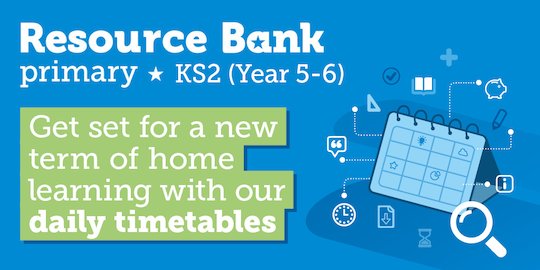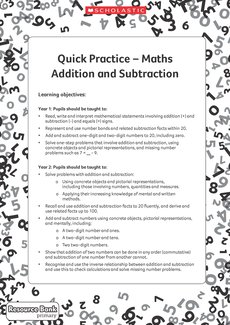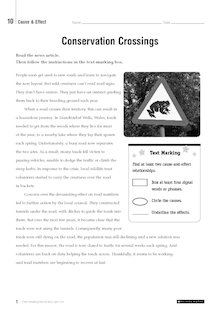Upper Key Stage 2 daily timetables – Week 1
- 5 Stars
- Supports home learning
Add to My Folder
We have created these Upper KS2 daily home-learning timetables to help your children aged 9-11 (Years 5-6) stay engaged and entertained from 9am–3.15pm!

Each timetable includes an hour’s learning on the core subjects of English and Maths, with sessions for other curriculum coverage and time for reading, breaks, snacks and daily exercise.
*Remember not all days will go to plan and your child might not always be able to sit and work quietly for the allocated time. If needed, allow your child/children to pick and choose which activities they would like to do, or encourage them to focus on just one piece of learning per day.
Timetables:
1. Monday
2. Tuesday
3. Wednesday
4. Thursday
5. Friday
Monday
| Time: | Subject: | Notes: |
|---|---|---|
| 9.00-9.30 | PE |
Outcome/purpose: Continuous exercise for 30 minutes. Instructions: Create an obstacle course using items around the home. Optional parent support: Help your child to plan their obstacle course. |
| 9.30-10.30 | Maths |
Outcome/purpose: Practise addition and subtraction skills. Practise multiplication skills. Instructions: Download the Quick Practice – Addition and Subtraction pack. Go to pages 11-12 (for Year 5 pupils) or 13-14 (for Year 6 pupils). Complete the activities on the pages. Tip: If you don’t have a 0-9 dice at home, write the numbers on scraps of paper. Fold them up and put them in a bowl and do a ‘lucky dip’ to find your random numbers! Optional parent support: Check your child’s answers for errors and help them with any corrections. Play the activities on page 12 or page 14 alongside your child and make it competitive. |
| 10.30-11.00 | Break |
Pop out for your daily walk or exercise!
Remember to have a healthy snack such as a piece of fruit and don’t forget to wash your hands before you eat. |
| 11.00-11.30 | Reading |
Outcome/purpose: To read for 30 minutes. Instructions: Snuggle up with a book! Choose one of your favourite books and read for half an hour. Optional parent support: Ask your child to read aloud to you and ask them questions about the story. Such as: Can you sum up that chapter in two sentences? Which words/phrases tell you he is angry? Describe that character using three words. |
| 11.30-12.30 | Geography and Science |
Outcome/purpose: To learn about climate change and the effect it has on the planet. Instructions: Download the PowerPoint Home Learning: Protecting Our Planet – Climate Change and the related activity notes Home Learning: Protecting Our Planet – Climate Change notes. Open the PowerPoint in ‘slideshow view’. Read the notes as you go through the slides and complete the activities. Optional parent support: Read through the PowerPoint and notes with your child and check that they understand the key causes of climate change and the tricky vocabulary. |
| 12.30-1.30 | Lunch | If you have a garden or balcony, try to get some fresh air after lunch. Remember to wash your hands before eating! |
| 1.30-2.30 | English |
Outcome/purpose: To develop understanding of the meaning of texts. Instructions: Download Close Reading Non-fiction – ‘Space to Play’ text and questions (for Year 5). Or Close Reading Non-fiction – ‘Conservation Crossings’ text and questions (for Year 6). Read the questionnaire responses or article and then follow the instructions in the text-marking box. Answer the questions on the next page. If you have time, complete the second page (KS2 version) of this Word Pronoun worksheet. Optional parent support: Use the answer sheet to check your child’s answers to the ‘Close Reading Non-fiction – ‘Space to Play’ or the ‘Close Reading Non-fiction – ‘Conservation Crossings’. Answers can be found here. |
| 2.30-3.15 | Art |
Outcome/purpose: To create a piece of modern art that carries a message about your life. Instructions: You will need: old newspaper and magazines, A3 paper, glue. Before you begin your art project, think about: the things, people, places, that are most important to you what you hope to do in the future the people and places you would like to see and visit in the future Next, look through magazines and newspapers for any photos, illustrations, and sections of text that tie in with your life now and also your ideas of what your life will be like in the future. It might be a single word like ‘CHAMPION’, which reminds you of winning a dance competition, or an animal photo which represents your aspirations of becoming a vet. Cut out the images and text and group them together to show the progression of your life. You can group them however you feel best suits the theme of your collage, or just to create the most pleasing effect. For instance, you could sketch a simple bare-branched tree, placing the collage pieces on the branches like leaves, or draw a tall sunflower, placing collage pieces up the stem like leaves, with the image of your main goal in the centre of the flower, right at the top. (Activity adapted from our Modern art article) Optional parent support: Help your child to select images and text from magazine and newspapers that reflect their life now and their future goals. Help them to decide how to arrange the images and text into a collage. Help them to make the links that a picture may represent. |
Already a member? Sign in below.
Published 17 April 2020
Reviews
Rated 5/5 from 1 rating
You need to be signed in to place a review.


